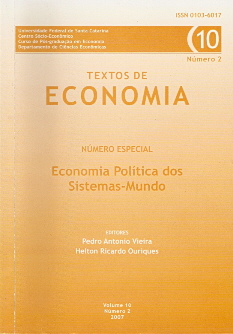Positioning in the world system and semiperiphery
DOI:
https://doi.org/10.5007/%25xAbstract
The purpose of this article is to examine the existence of country groups, especially the semiperipheral ones, in the world economy income distribution drawing on a systemic perspective derived from the works of the World-Systems Analysis. The concepts of Scientific-Technical Revolution and new International Division of Labour are likewise relevant to the analysis. Thus, a new methodology was developed based on Arrighi & Drangel’s (1986) operational suggestion aiming at assessing the centresemiperiphery-periphery stratification predicted in the theory. By means of data exploratory techniques like cluster analysis, stable groups which are representatives of a polarized structure as well as the triadic one were found in the period 1950- 003. The consideration of data regarding industrial activities and world trade can favour a more precise definition of the positioning of the countries. Lastly, Brazil’s semiperipheral character, marked by heterogeneity in domestic production and in the insertion in world commodity chains, is observed.Downloads
Published
Issue
Section
License
Os Direitos Autorais para artigos publicados neste periódico são do autor. Em virtude de aparecerem nesta revista de acesso público, os artigos são de uso gratuito, com atribuições próprias, em aplicações educacionais, de exercício profissional e para gestão pública. A Revista adotou a licença Creative Commons - Atribuição-NãoComercial-SemDerivações 4.0 Internacional. Esta licença permite acessar, baixar (download), compartilhar o conteúdo dos artigos desde que citada a fonte, atribuindo os devidos créditos de autoria.

Esta obra está licenciada sob uma Licença Creative Commons - Atribuição-NãoComercial-SemDerivações 4.0 Internacional.



